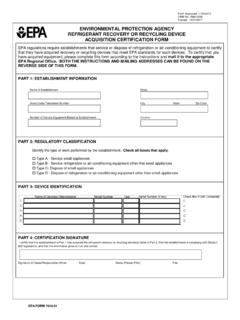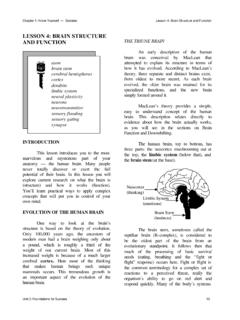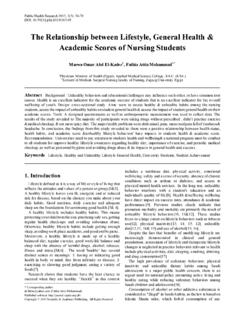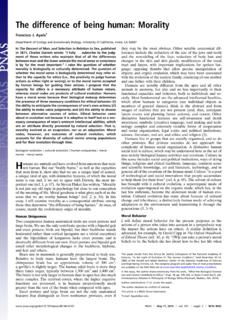Transcription of First published in the NeuroLeadership journal
1 SCARF: a brain - based model for collaborating with and influencing others First published in the NeuroLeadershipjournal iSSue oNe 2008 NeuroLeadershipjournal research SCARF: a brain - based model for collaborating with and influencing others David rock Ceo, Results Coaching Systems international, GPo Box 395, Sydney, NSW Australia 2001 Faculty, CiMBA Co-founder, NeuroLeadership institute editor, NeuroLeadership journal In a world of increasing interconnectedness and rapid change, there is a growing need to improve the way people work together.
2 Understanding the true drivers of human social behavior is becoming ever more urgent in this environment. The study of the brain , particularly within the field of social, cognitive and affective neuroscience is starting to provide some underlying brain insights that can be applied in the real world (Lieberman, 2007). Social neuroscience explores the biological foundations of the way humans relate to each other and to themselves and covers diverse topics that have a different degree to which they can be operationalized and unambiguously tested. Topics include: theory of mind, the self, mindfulness, emotional regulation, attitudes, stereotyping, empathy, social pain, status, fairness, collaboration, connect-edness, persuasion, morality, compassion, deception, trust and goal pursuit.
3 From this diversity, two themes are emerging from social neuroscience. Firstly, that much of our motivation driving social behavior is governed by an overarching organizing principle of minimizing threat and maximizing reward (Gordon, 2000). Secondly, that several domains of social experience draw upon the same brain networks to maximize reward and minimize threat as the brain networks used for primary survival needs (Lieberman and eisenberger, 2008). in other words, social needs are treated in much the same way in the brain as the need for food and water. The SCARF model summarizes these two themes within a framework that captures the common factors that can activate a reward or threat response in social situations.
4 This model can be applied (and tested) in any situation where people collaborate in groups, including all types of workplaces, educational environments, family settings and general social events. The SCARF model involves five domains of human social experience: Status, Certainty, Autonomy, Relatedness and Fairness. Status is about relative importance to others. Certainty concerns being able to predict the future. Autonomy provides a sense of control over events. Relatedness is a sense of safety with others, of friend rather than foe. And fairness is a perception of fair exchanges between people.
5 These five domains activate either the primary reward or primary threat circuitry (and associated networks) of the brain . For example, a perceived threat to one s status activates similar brain networks to a threat to one s life. in the same way, a perceived increase in fairness activates the same reward circuitry as receiving a monetary reward. The model enables people to more easily remember, recognize, and potentially modify the core social domains that drive human behavior. Labelling and understanding these drivers draws conscious awareness to otherwise non conscious processes, which can help in two ways.
6 Firstly, knowing the drivers that can cause a threat response enables people to design interactions to minimize threats. For example, knowing that a lack of autonomy activates a genuine threat response, a leader or educator may consciously avoid micromanaging their employees or students. Secondly, knowing about the drivers that can activate a reward response enables people to motivate others more effectively by tapping into internal rewards, thereby reducing the reliance on external rewards such as money. For example, a line manager might grant more autonomy as a reward for good performance. 1 3research NeuroLeadershipjournal Before exploring the domains of SCARF individually a
7 Brief context of the underlying science of the SCARF model , Namely, the approach (reward)-avoid (threat) response and the impact of this response on mental performance, is provided. Foundations of the scarF model The approach (reward)-avoid (threat) response: a survival instinct According to integrative Neuroscientist evian Gordon, the minimize danger and maximize reward principle is an overarching, organizing principle of the brain (Gordon, 2000). This central organizing principle of the brain is analogous to a concept that has appeared in the literature for a long time: the approach-avoid response.
8 This principle represents the likelihood that when a person encounters a stimulus their brain will either tag the stimulus as good and engage in the stimulus (approach), or their brain will tag the stimulus as bad and they will disengage from the stimulus (avoid). if a stimulus is associated with positive emotions or rewards, it will likely lead to an approach response; if it is associated with negative emotions or punishments, it will likely lead to an avoid response. The response is particularly strong when the stimulus is associated with survival. other concepts from the scientific literature are similar to approach and avoidance and are summarized in the chart below.
9 The approach-avoid response is a survival mechanism designed to help people stay alive by quickly and easily remembering what is good and bad in the environment. The brain encodes one type of memory for food that tasted disgusting in the past, and a different type of memory for food that was good to eat. The amygdala, a small almond-shaped object that is part of the limbic system, plays a central role in remembering whether something should be approached or avoided. The amygdala (and its associated networks) are believed to activate proportionally to the strength of an emotional response.
10 The limbic system can processes stimuli before it reaches conscious awareness. one study showed that subliminally presented nonsense words that were similar to threatening words, were still categorized as possible threats by the amygdala (Naccache et al, 2005). Brainstem Limbic networks process threat and reward cues within a fifth of a second, providing you with ongoing nonconscious intuition of what is meaningful to you in every situation of your daily life (Gordon et al. journal of integrative Neuroscience, Sept 2008). Such studies show that the approach-avoid response drives attention at a fundamental level nonconsciously, automatically and quickly.














